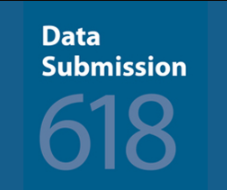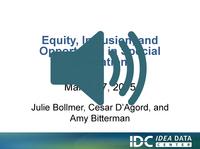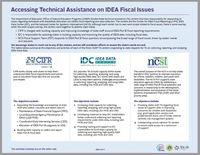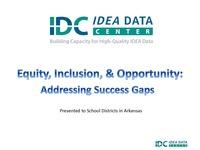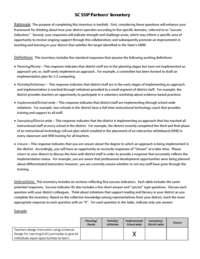Site Search
Results 43 - 49 of 355
Format: Applications and Spreadsheets
SEA EDFacts Edit Check and Data Display ToolsIDC's SEA and LEA EDFacts Edit Check and Data Display Tools for assisting states as they prepare their Part B data submissions. States can use the tools to identify potential edit check errors or errors in subtotals or totals prior to submitting the data to OSEP. Several of the tools are updated versions of the DTS originally published by (DAC), and this resource includes a zip file of 508 accessible versions of those tools. The MOE and CEIS Edit Check and Data Display Tools that IDC and CIFR developed allows states to input LEA-level data into the base data tab and generates edit check messages that are displayed in the auto-calculations tab.
Format: Recordings
OSEP Data Technical Assistance Centers: Collaborating to Assist State AgenciesOver the past few years, OSEP has changed the way it provides technical assistance to Part B SEAs and Part C LAs. This session will provide an overview of OSEP’s data technical assistance investments, including DaSy, IDC, CIID, and CIFR. Presenters discussed how these centers are working together to improve states’ capacity to collect, report, and analyze high-quality IDEA data. Presenters provided information about the type of work on which each center focuses and how the centers collaborate to provide assistance to states.
Format: Recordings
Equity, Inclusion, and Opportunity in Special Education WebinarIn this webinar, which IDC staff presented for the University of Tennessee’s Boling Center for Developmental Disabilities, we first discuss the requirements in the IDEA related to disproportionality, describe methods for calculating disproportionality, and present data, both at the national level and for the state of Tennessee. The second part of the webinar introduces a research-based guidance document and self-assessment rubric designed to help schools and districts identify the root causes of "success gaps."
Format: Reference Materials
Accessing Technical Assistance on IDEA Fiscal IssuesThis flyer is meant to help states better understand the three TA centers that are responsible for responding to issues regarding IDEA fiscal reporting and data collection: IDC, CIFR, and NCSI .The flyer contains, a chart with each center’s objectives and activities that are related to IDEA fiscal data.
Format: Presentations
Equity, Inclusion, & Opportunity: Addressing Success GapsThis presentation introduced the audience of local education agency personnel to new tools, the Equity, Inclusion, and Opportunity: How to Address Success Gaps Rubric and the Equity, Inclusion and Opportunity: How to Address Success Gaps White Paper. The rubric and white paper were developed by a group of OSEP-funded technical assistance providers, with input from states and other experts. The Equity, Inclusion, and Opportunity: How to Address Success Gaps tools provide a process for reducing the differences in school success among subgroups of students by providing a structure for districts or schools to examine their current practices and identify areas for improvement.
Format: Presentations
IDEA and FERPA - Understanding the BasicsThis presentation informed participants of the privacy provisions under IDEA Part C, IDEA Part B, and FERPA. It covered the basics surrounding the legal requirements related to the protection of PII about children with disabilities and where to go for help with questions about privacy. The audience for the presentation included administrators and practitioners who are concerned with providing services for children and youth while maintaining the privacy of the children and youth they are serving.
Format: Guides, Papers, and Reports
South Carolina SSIP Partners’ InventoryAs a part of developing their SSIP Phase I, the South Carolina Department of Education chose to use the IDC Equity, Inclusion, and Opportunity: How to Address Success Gaps, Rubric to inform their work. SC state staff developed the SC SSIP Partners' Inventory by reformatting content in the Success Gaps rubric, breaking apart some of the more complex components of the rubric into more concise elements that could be rated more easily on a Likert-type rating scale.


